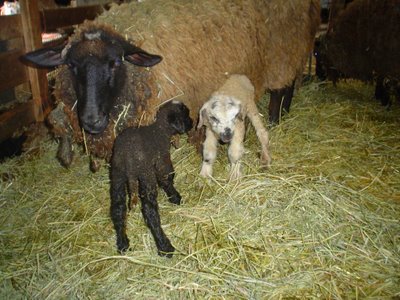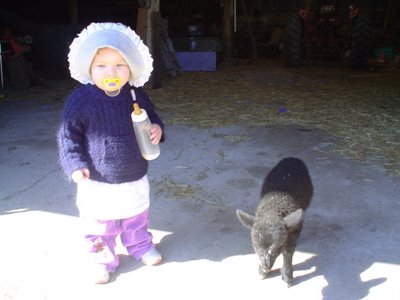 We had quite a successful lambing this year. We had only one singleton birth. All of the rest were twins! This is my favorite set of twins. One is white with dark spots, the other is dark with white spots. It's like one is a negative of the other. The white one is a wee little ram and will be a wedding gift for my cousin. They want a couple of "mowers' for their lawn.
We had quite a successful lambing this year. We had only one singleton birth. All of the rest were twins! This is my favorite set of twins. One is white with dark spots, the other is dark with white spots. It's like one is a negative of the other. The white one is a wee little ram and will be a wedding gift for my cousin. They want a couple of "mowers' for their lawn. Willow is trying to give the lamb a nice bottle of lamb replacement milk. This lamb was one of a set of twins. When I found her she was very hypothermic. She almost didn't make it. I usually bring a lamb in the house for a few hours when they get chilled. I tuck them up in blankets with a hot water bottle. Unfortunately when you do this the lambs mother often doesn't recognize her baby when she is returned. She loses the scent recognition. Sometimes I can get mama to acknowledge her babe with a little effort, but other times I just have raise baby on the bottle. This is Genevieve and we have another bottle baby named Bebe.
Willow is trying to give the lamb a nice bottle of lamb replacement milk. This lamb was one of a set of twins. When I found her she was very hypothermic. She almost didn't make it. I usually bring a lamb in the house for a few hours when they get chilled. I tuck them up in blankets with a hot water bottle. Unfortunately when you do this the lambs mother often doesn't recognize her baby when she is returned. She loses the scent recognition. Sometimes I can get mama to acknowledge her babe with a little effort, but other times I just have raise baby on the bottle. This is Genevieve and we have another bottle baby named Bebe.I will try to post a picture of a new skirt I finished recently. I've been reading books about quilting and am finally learning some of the time saving techiniques for cutting and sewing patchwork. I hope to make a top to go with the skirt this week. Maybe I will wait until I get that finished before I post it.
Another thing that has kept me hopping is working for Leslie. I need to correct the number of alpacas she owns. The actual number is over 70 of this beautiful animals!!!! 40 of them are due to start birthing any day now. I'll try to post more pictures of the beautiful alpaca fiber. This stuff spins up like a dream! I feel very lucky to get to work with it.
I've also had a chance to help out on a couple of shearing days (although there were so many volunteers I felt like a bit of a fifth wheel most of the time). It was a learning experience though. Shearing alpacas is not one bit like shearing sheep. It takes at the very least 15 minutes to shear each animal, though more likely half an hour or more to finish. The alpaca is strapped to a table to keep her from getting injured. One side is sheared and then she is gently rolled over to have her other side shorn. Once shorn the fleece must be divided into different bags according to quality. First cut is the blanket (hair from shoulders, back, flanks). This is the best, longest cleanest fibre. Second cut is upper thighs and neck. This stuff will be sent to the mill for processing, rovings, quilt batting etc. The fibre that is realy short or dirty, lower leg and belly hair goes into a bag labelled thirds and is for felting, shoe and boot liners etc.
While the animal is on the table it's a great opportunity to do whatever care maintenence she needs. She will get her toenails trimmed, get whatever dental care she needs (this can be disturbing not only for the animal but for the human handlers who have that psychological aversion to nasty denist drill sounds, ewwww, sounds just like it!!!) She might get her top knot (the hair on the top of her head) trimmed and brushed. It's a good time to notice any other health problems the animal might have. In other words it's a big, big job! Not the 5 minute buzz cut that you see with sheep! I learned so much!
I hope this big long entry makes up for the 2 months of neglect to this blog. It's too hard to keep up with it with a 19 month old , an 9 year old, a 11 year old and too many hobbies, jobs, ideas etc.,
Until next time, TTFN
kathy

No comments:
Post a Comment